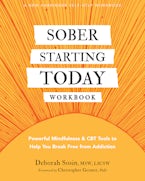By Deborah Sosin, MSW, LICSW, author of Sober Starting Today Workbook
If you’re thinking about changing your relationship with alcohol but missed out on Dry January this year, don’t worry. You can always hop on to Sober Spring, an extension of the popular sobriety challenge, which runs from March 20 to June 20.
For those who don’t know, Dry January and Sober Spring are part of a movement started in 2013 in the UK to help people stop drinking. If you’re not ready to quit outright, you might try the concept of Damp January, geared to folks who want to cut back on alcohol without giving it up entirely.
During the designated period, you tally up not just your drinking behaviors but also money saved, sleep gained, weight lost, time found, and other proven benefits.
Sounds great, yes?
Well, yes and no. Keeping score is fine as far as it goes. But, as a therapist specializing in substance use disorders, I believe those external, numerical markers end up yielding more metrics than meaning.
To achieve lasting change, we need to dig deeper, to understand our true motivations, and acknowledge our mixed feelings and conflicting values, too.
With a tool called the decisional balance exercise, you (or your family, friends, or clients) can take an unflinching look at your choices and their consequences. Whether or not you end up embracing the “decision” part—if to change, how to change—this tool provides a clear view of all aspects of your behavior.
Developed by psychologists James Prochaska and colleagues, this exercise helps you identify the pros and cons of a particular behavior, and I like to add a bonus angle, as you’ll see.
By the way, you can try this for any aspect of your life that you’re considering changing—eating, using drugs, exercising, switching jobs, leaving a relationship, moving to a new place, making a big investment, and so on. Here’s how it works:
• First, create a chart with four boxes and label them with the headings shown in the sample below.
• Next, pick one box. Write down everything you can think of for that category. Be honest. Avoid self-criticism. Embrace a spirit of curiosity and self-compassion.
• Include any physical, emotional, financial, relational, spiritual, sexual, legal, social, professional, or education-related aspects of your drinking.
• When you’re ready, move to the next box, then the third and fourth.
• Some overlap among boxes is inevitable. That’s OK. It helps to look at the same thing from a slightly different perspective.
• Quantity doesn’t matter. You might have two items in one box and twenty in another.
Now, the bonus angle, which makes this different from a regular pros-and-cons exercise. Review your lists, close your eyes, then ask yourself what one item in each box is the most important emotionally, or, put another way, has the most emotional kick? Mark those four items with an asterisk.
For example, take the case of Jamie, who is sober curious—that is, questioning the costs and benefits of drinking alcohol and deciding whether to make changes.

Jamie’s asterisked items revealed buried feelings such as fear, anxiety, and shame—and especially insecurity about fitting in. Working with those emotions and their roots led to more self-understanding and a greater sense of empowerment.
Jamie eventually cut back on drinking, and two friends unexpectedly decided to do the same. These days, they attend more events where alcohol is not the central focus, and Jamie doesn’t feel the inner pressure to be “part of the group.” Rather than identifying as a “loser,” Jamie said, “Now I’m more of a leader!”
Ask yourself how you feel looking at your list. Where are your asterisks, and why? What patterns do you see? When did they start? Any surprises? What feelings came up? What are your values about your behavior? What are your memories, worries, fears, fantasies, hopes? Are you ready to make a change? If so, what are your next steps?
And remember, you don’t need to download an app or wait for a certain date—you can start when you feel ready!
As you explore your relationship with alcohol in this deeper way, check in with yourself over time, with curiosity and compassion. Change is a process, rarely linear, always evolving. By adding the internal work to the external work, you’re bound to develop a powerful set of skills that can guide you toward a more balanced and healthy life.
Important! Do not quit drinking suddenly if you are chemically dependent on alcohol. It can lead to severe withdrawal symptoms such as shaking, sweating, hallucinations, seizures, or death. If you think you are at risk, consult your doctor for help finding compassionate professionals who are experienced in the treatment of chemical dependency. You may also call the federal government’s Substance Abuse and Mental Health Services Administration (SAMHSA) national helpline, which offers confidential free help and information for substance use and addiction treatment services, at 1-800-662-4357.
Deborah Sosin, MSW, LICSW, is a writer, editor, and clinical social worker specializing in mindfulness and addictions. She holds an advanced certificate in mindfulness-based psychotherapy from the Institute for Meditation and Psychotherapy, and is author Sober Starting Today Workbook and the award-winning picture book Charlotte and the Quiet Place.



 Part 2: What to Do When a Client Is Participating in Self-Judgment?
Part 2: What to Do When a Client Is Participating in Self-Judgment?